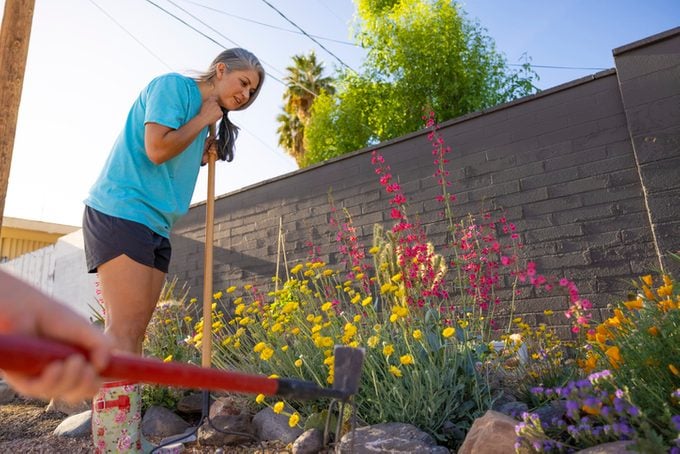Save water and money with these charming, low-maintenance plants.

How to Make an Eco-Friendly Succulent Yard

In this age of climate change, many homeowners are looking for creative ways to beautify their yards beyond the traditional grass lawn. After all, sprinklers, hoses and irrigation systems use thousands of gallons of the finite resource each month—not to mention costing you hundreds in water bills. To help combat excessive water usage, homeowners are turning to eco-friendly lawn alternatives, from turf to native grasses to wildflowers.
In California, homeowners have gone the extra mile to reduce water usage in their drought-ridden state by planting their yards with succulents and cacti. The exotic plants not only offer a modern, colorful aesthetic but slash water usage by up to 88% (assuming a traditional yard is watered twice weekly). If you’re looking for an eco-friendly yard option, but still want the curb appeal of plants, it doesn’t get much better than this!
Why Are Succulents Eco-Friendly?
In the words of Angelica Elliott, assistant director of public horticulture at the Desert Botanical Garden in Phoenix, a succulent is defined as “a plant that can store water in its leave, stems and/or roots and uses that stored water during periods of drought.” This unique ability to store water distinguishes succulents from other plants and explains why they require so little watering. And according to Energy Star, less home water usage means that more water can stay in our rivers, bays and estuaries, promoting healthy watersheds and saving wild animals.
Are Succulents Good for Outdoor Landscaping?
Succulents are amazingly adaptable plants. While you may think of them primarily as houseplants, they can thrive in most outdoor climates. This is because, over centuries, they have evolutionarily adapted to extremely harsh climates, from arid deserts to frost-prone areas. In addition to their weather-hardiness, their gorgeous diversity makes them an effortless fit for large-scale landscaping. Whether you’re looking for a pretty ground cover or statement planter, succulents have you covered.
Will a Succulent Yard Work in My Climate?

Succulents generally prefer temperatures of 70 to 95 degrees. However, many varieties thrive at lower temperatures, such as sempervivum and sedum. Additionally, succulents typically like at least six hours of sunlight a day, according to Elliott. Still, this varies by plant type: “Some [succulents] do well with direct sunlight if summer temperatures are mild. However, in deserts (extreme heat), many succulents prefer some afternoon shade.”
To determine which succulents might be right for your climate, check your plant hardiness zone before shopping. Additionally, when sourcing succulents, remember that you can often get free clippings from a propagating friend.
What Materials Do I Need for a Succulent Yard?
In addition to a variety of climate-friendly succulents, you’ll need the right soil. Elliott recommends using slightly alkaline soil with a well-draining sandy or silty mix. SF Gate specifically suggests an equal blend of builder’s sand, gravel or pumice, and potting mix. If you have clay soil in your yard, that’s fine, but add some of the aforementioned topsoils on top for optimal succulent health.
Crushed rocks or pebbles in various contrasting colors can also add structure and visual appeal to your display. Popular choices include red lava rocks, desert gold rocks and Mexican beach pebbles.
How Do I Plant a Succulent Yard?
Once you’ve gathered your materials, set up your new yard using the following steps.
- Remove grass. If required, clear out any existing grass, rocks and weeds for a clean slate for planting.
- Spread out your soil. Sprinkle that mix all over your yard. It should be at least three inches deep, but up to eight inches is ideal for maximum drainage.
- Plan your placement. Just as you would plan a garden, be sure to carefully plan your succulent yard. Try placing potted succulents in different locations to check the overall effect. For extra fun, experiment with “rock rivers,” localized arrangements and even hills of soil to add dimension.
- Plant your succulents. Remember to leave room between plants to accommodate spreading and plant on top of soil mounds to promote drainage.
- Give it the first water. Wait a week before watering to let the succulents recover from transplanting. Then, water until the soil is completely moist (not sopping), about five minutes.
How Do I Maintain a Succulent Yard?
The upkeep is pretty straightforward from here on out. Here are the three tasks you’ll need to perform regularly.
Water
Water the yard when the soil has completely dried out. In the spring and summer, this is typically once or twice a month. In the fall and winter, try every other month. The biggest liability of succulents is root rot, so do not overwater!
Fertilize
Use a half-strength, phosphorus-rich houseplant fertilizer once in the spring and once in the summer.
Weed
As with a traditional lawn, remove any weeds that threaten to steal valuable space or nutrients from your succulents.
And that’s it! Now, go enjoy your new succulent yard. We hope you love it as much as we love this eco-friendly trend.



















